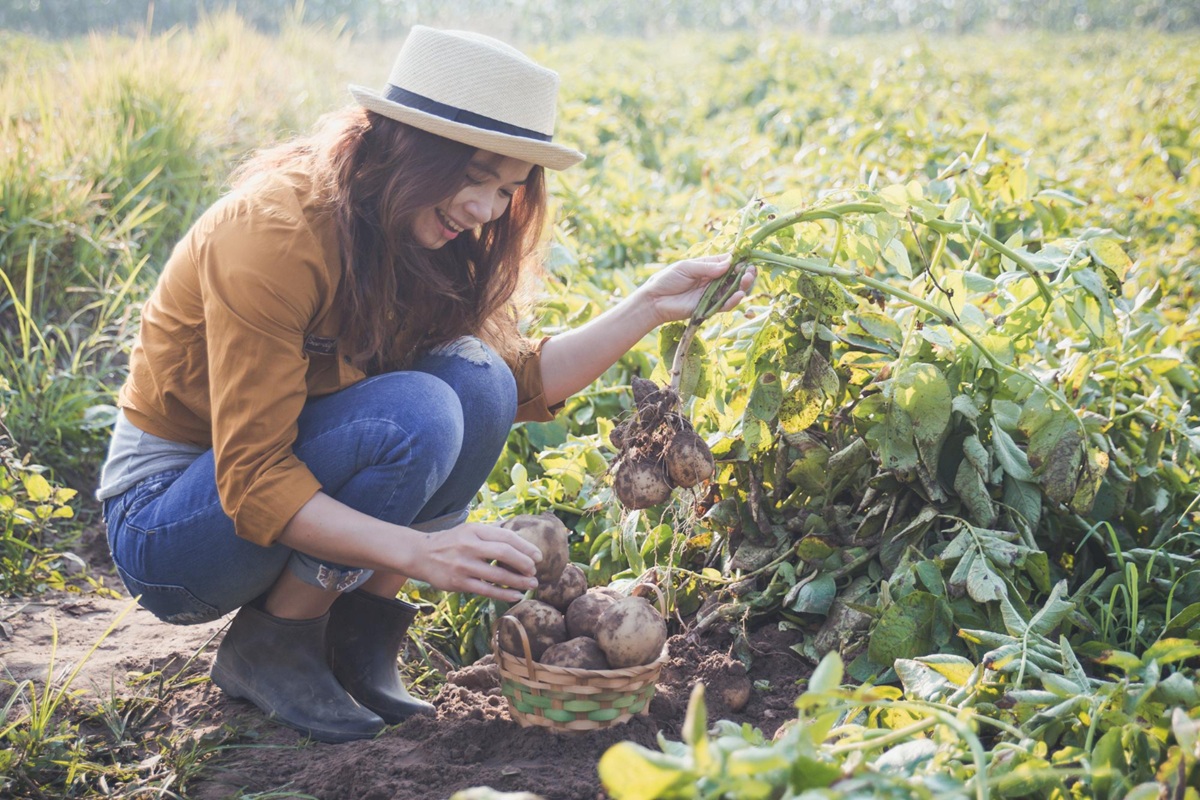Growing potatoes in your own garden is a dream come true for many amateur gardeners! However, you might have some questions regarding the best planting time, soil preparation, or the necessary care to ensure a bountiful and healthy harvest.
Don’t worry, we’re here to provide a detailed, step-by-step guide to assist you on this gardening adventure.
When to Get Potato Plants?
Seed potatoes, those small certified tubers that are healthy and disease-free, start appearing in specialty shops by mid-December. If you want a wide selection, it’s best to purchase your plants at the beginning of the year.
These precious plants can wait for a few weeks in a cool, dark place. A handy tip to check if your plants are ready? The shoots should ideally reach 1 to 2 cm.
If they aren’t ready yet, don’t stress: a few weeks in the light will help them sprout properly.
What Is the Ideal Period to Plant Your Potatoes?
Generally, potato planting occurs when the soil reaches at least 10°C, which signifies it has warmed up in spring. For most regions, April is the ideal month. If you are in an area where nighttime frost is still a concern, it’s better to wait until the end of April to avoid cold damage.
Is your climate rather cold, mountainous, or late? Plant in early May or consider planting under cover (in a tunnel or hotbed).
On the other hand, if you enjoy a mild climate, you can start as early as March, or even February in certain coastal or southern areas. However, be cautious: these early plantings require much more attention and experience!
Preparing the Soil Before Planting
It cannot be emphasized enough: the success of your potatoes begins with good soil preparation a few days or weeks beforehand.
Use a broadfork or garden fork to aerate and loosen the soil well. The secret to good soil? Wait until the soil has dried out a bit, meaning it should be moist but not waterlogged: overly saturated soil is hard to work and creates a poor structure for your harvest.
While turning the soil, try to maintain the natural order of soil layers by keeping the humus on the surface. This way, you’ll help preserve the richness of underground life.
How to Fertilize Your Crop Naturally?
The potato is quite a hungry plant. To maximize your yield, adding natural fertilizers is highly recommended. You can simply scratch these elements into the soil:
- Wood ash adds potassium and reduces acidity. Be careful, a handful per square meter is more than enough and is not suitable for already alkaline soils.
- Compost or well-rotted manure, preferably straw-based or in granules, is great, but follow the recommended quantities on the packaging.
Techniques for Properly Planting Your Potatoes
- Before planting, anticipate the essential hilling: form small mounds along each row. For spacing, allow 65 cm between rows and 35 cm between early varieties. For late varieties, aim for 70 cm between each row and at least 40 cm between the plants.
- To make planting easier, feel free to stretch a string between two stakes or use row markers.
- During the actual planting, dig holes 10 cm deep, place the plant with the sprout facing up or to the side, then cover with 5 to 10 cm of soil. A deeper planting is preferable in areas prone to late frosts.
Good Practices Throughout the Growth Until Harvest
Hilling Is Essential to Protect the Yield
Hilling involves regularly covering the young shoots emerging from the soil with earth. This prevents the tubers from turning green and protects them from potential late frosts. Two hillings spaced 2 to 3 weeks apart should suffice.
Regular and Moderate Watering
During hot or dry periods, make sure to adequately water your plants. This regular watering can sometimes double your final yield!
Topping Is a Useful Step
Depending on your variety (generally count 70 to 120 days of growth), cut the tops three weeks before harvest. This action enhances the flavor and limits late-season blight development.
Harvesting and Storing Your Potatoes Easily
Harvesting your potatoes is a true joy in the garden: grab a garden fork and gently lift each plant. Depending on the varieties and conditions, each plant yields between 500 grams and 2 kg of potatoes.
Consume your early varieties quickly, kept cool, to enjoy their tender flesh. For long-storage varieties, allow your potatoes to dry, then store them in a cool, dark, and ventilated place, like a cellar. Check on them regularly and remove any sprouts during winter.
Have you grown your own potatoes at home? What tricks work best for you? Please leave a comment below. Your experience interests us and could help other readers! It’s your turn to share!
I’m a disabled, xennial Christ-follower, slightly off kilter (but aren’t all “ar-teeests”?).
Hope you enjoy my rantings, don’t take my sarcasm too seriously and know that comments are welcome. 🙂


Leave a Reply